What's On Celebrations | Exhibitions | Biennale | Mostra Cinema
Celebrations Historical Regatta | Redentore | Salute | Vogalonga | Marathon | Marys | St Martin
The Feast of the Marys or Festa delle Marie in Venice
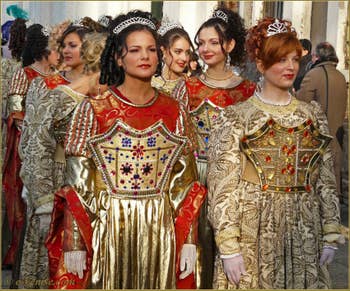
The Feast of the Maries
La Festa delle Marie: the oldest festival in Venice
Date of the Feast of the Marys 2025 in Venice
The Feast of the Marys will take place on 22 February 2025.The Feast of the Marys is said to be the oldest festival in Venice.
The Festa delle Maries was in fact instituted to commemorate Venice's victory, in 943 (or 944 depending on the source), over pirates who had come to challenge it by kidnapping twelve young girls during the traditional Wedding Feast in the church of San Pietro del Castello, in the presence of the Doge and their future spouses.
Removed from their unpleasant surprise, the bride and groom immediately set off in pursuit of the pirates, led by the Doge, and freed their beloved, who were then carried in triumph through the city.
Since this event rich in emotion, the wedding feast or "Festa dei Matrimoni" became the "Festa delle Marie" (Maria in the singular becomes Marie in the plural in Italian), the Feast of the Maries, to honour the purity and beauty of the young girls who married on this day of the purification of the Virgin Mary.

The Feast of the Maries The festival was subsequently abolished in 1380, and then neglected for many centuries, reduced to a mere commemoration with the doge's annual visit to the church of Santa Maria Formosa, until the fall of the Republic in 1797.
Fortunately, the Venetian director Bruno Tosi, and the regional daily "Il Gazzettino", had the good idea of relaunching the Festa delle Marie in 1999, by organising the election of twelve Marie(s) and their twenty-four bridesmaids.
They are selected from among the young and beautiful candidates, who must be aged between sixteen and twenty-seven. Dressed and coiffed in 14th-century fashion, the bridesmaids also take part in the opening ceremonies of the Venice Carnival.
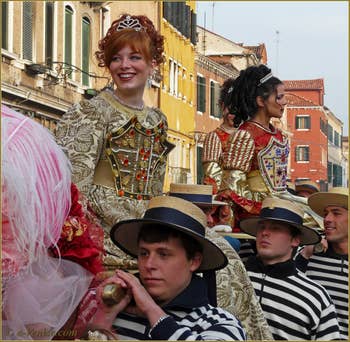
The Festival of the Maries As in the past, the splendid procession of the Maries, carried by sturdy young Venetians, departs from the church of San Pietro di Castello, along Via Garibaldi and Riva degli Schiavoni, to arrive in Piazza San Marco.
A festival whose origins can also be traced back to the Orient.
Legend has it that survivors of the Trojan War came to settle in the lagoon around Chioggia and on the islands of Torcello and Burano, led by Antênor, a Trojan hero like Aeneas.
The highly solemn nature of the wedding and the fact that it was celebrated with great pomp in a collective ceremony would confirm the oriental origin of this religious ceremony, which consecrated the union of young couples from all over Venice (from Venice, the islands of the lagoon and the mainland) with their families and all their friends in the procession.

The Feast of the Maries To better understand the origins of the Festa delle Marie, we need to look back to the Festa dei Matrimoni, which in the ninth and tenth centuries brought together all the Venetian people around the Doge, who attended the ceremony with his entire retinue.
The Festa dei Matrimoni was first celebrated on the thirty-first of January (the day on which St. Mark's body was transferred to Venice), and then on the second of February (the day of the purification of the Virgin Mary), in the church of St. Mark in Castello by the patriarchal bishop of Venice. These dates are the origin of the Festa delle Marie.
The Festival of beauty, fertility and virtue

The Feast of the Maries At the end of the 9th century, to celebrate the Feast of the Brides in the cathedral of San Pietro del Castello.
It was then called Olivolo, because the island on which it was located was oval in shape.
The Venetian government had decreed that twelve of the poorest girls, both beautiful and virtuous, should be chosen so that the Serenissima could give them a dowry and lend them a magnificent dress and jewels for this great day.

The Feast of the MariesTheir dresses and the long, shoulder-length veil were white as a sign of purity, while their crowns and necklaces of gold and jewels enhanced their beauty and gave a special lustre to this moving ceremony.
Adorned in their finest finery, the girls would then go to the church of San Pietro in Castello, with their dowry contained in a small box called an arcella.
There they waited for their future husbands, who would join them in the procession of friends and family, as well as the crowd of spectators who had come to share their joy and admire the spectacle.
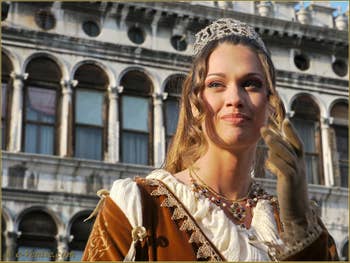
The Feast of the Maries Together, they listened to the mass celebrated by the Patriarch of Venice, a mass presided over by the Doge himself.
The happiness and strength of love consecrated by marriage, the commitments between spouses and the duties imposed on them by God, were widely evoked and emphasised by the bishop during his sermon.
The presence of the Doge and his retinue in the middle of the assembly elevated this beautiful event to the dimensions of the Republic: the importance of the couple in civil society was thus underlined, as was the strength of the social bond between citizens gathered around their leader, who had come to share their joy.

The Feast of the Maries For the Republic of Venice, this festival was a very pleasant way of strengthening the bonds of solidarity and fraternity that were the basis of the city's stability.
Every year, the Venetians would gather in joyous crowds to admire the brides and gather around their Bishop and Doge, until one day... pirates from a neighbouring country launched a surprise attack to kidnap the brides.
The pirates attack in the middle of the ceremony and kidnap the girls right under the Doge's nose!!!

The Feast of the Maries The event took place on 31 January 943, (or 944, the date varies according to sources) at a time when the Feast of the Marys still coincided with the anniversary of the arrival of the body of St. Mark in Venice.
On that day, everyone attended the ceremony, unaware that pirates from Istria had just landed very discreetly on the island of Olivolo, hoping to create a surprise by attacking in the middle of the ceremony and at the same time demonstrate the vulnerability of the Serenissima, whose economic boom was arousing a great deal of envy and jealousy at the time!
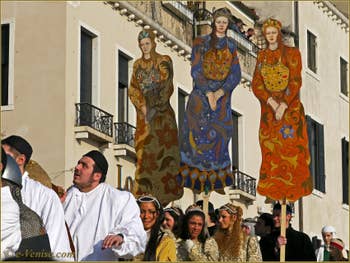
The Feast of the Maries And so, in accordance with their plan, the pirates burst into the cathedral, killing or wounding those who tried to stop them, seized the girls and their "arcelle" and then fled under full sail, taking them by force with them.
The Venetians find the pirates at Caorle
The Doge, Pietro Candiano III, then decided to set off immediately in pursuit of the pirates, and did so by calling all the Venetians for help. The men of the Confraternity of the Casseleri were the quickest and most numerous to embark with the Doge to pursue the pirates.They found them at Caorle, a port on the mainland, when they were already dividing up the dowries and young girls they hoped to sell as slaves in the Orient...
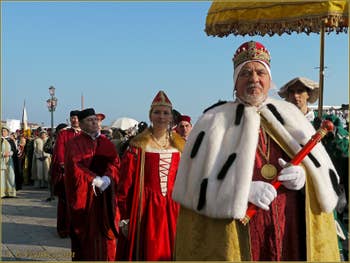
The Feast of the Maries Fortunately for them, the Venetians' attack was swift, effective and... merciless for their captors. The honour of Venice and its brides was safe
. It was also in memory of this memorable event, in which the Venetians had shown all their courage and attachment to their beloved, that the port of Caorle was named "the Port of the Damsels": "il Porto delle Donzelle".
The Doge's promise to the Casseleri
The Casseleri, who had played a major role in this affair, were craftsmen whose trade consisted of making night tables, boxes for storing grain, salt and spices, as well as the famous "arcelle" that contained the trousseau or dowry of young brides.
The Feast of the Maries The Casseleri's profession had a strong symbolic connotation of preservation and protection, which explains their prompt and effective commitment to going to the rescue of young brides.
The headquarters of the Casseleri Brotherhood was next to the church of Santa Maria Formosa, just to the right of the entrance to its campanile.
Also, when the Doge asked them what they wanted as a reward, they replied:
"May your Lordship come every year to visit us at Santa Maria Formosa!"
The Doge tried to test them by saying:
- But what if it were to rain?
- Then we would give You a hat to cover Yourself!
- What if We were thirsty?
- We'd offer You a drink!
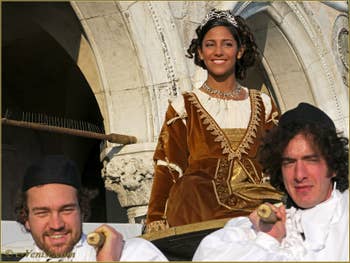
The Feast of the Maries Faced with such dedication, the Doge couldn't refuse!
This little episode is the origin of the Doge's annual visit to Santa Maria Formosa during the Feast of the Maries.
The Doge would arrive at the church via the bridge known as Ponte delle Bande (perhaps because it was the first Venetian bridge to be equipped with parapets).
The parish priest of Santa Maria Formosa was waiting for him at the bottom of the bridge, where he spread a tablecloth to block his way.
In order to pass, the Doge had to throw a bleached copper coin on the ground called "bianca" and which the people had nicknamed "el vien".
And just before the Doge entered the church, the Casseleri paid tribute to him, reminding him at the same time of his promise, namely by offering him a basket containing a straw hat to protect him from the rain, and a bottle of malvasia wine accompanied by a few oranges to quench his thirst....
The Festival of Weddings becomes the Festival of Brides or Festa delle Marie
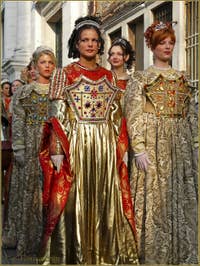
The Feast of the Maries After defeating the pirates and recovering the brides, on the second of February, the day of the purification of the Virgin Mary, a great ceremony was held to celebrate the return of the young brides, who were happy and proud to be carried in triumph through the whole town in jubilation.
This is how the Festival of Weddings became the Festival of Brides, the festival of innocent and pure brides like Mary, the mother of Christ.
And the name Festival of the Brides was all the more justified as it ended with the Doge's visit to Santa Maria Formosa, which, at the time, was the only church in Venice dedicated to the Virgin Mary.

The Feast of the Maries The Maries were chosen directly by the Venetians: two of the most beautiful and wise girls were chosen for each Sestier, and as there are six Sestieri in Venice, that made twelve.
It was then up to the Doge to confirm their choices.
The Festa delle Marie in its heyday
And the Feast of the Marys, set from then on for two February, became increasingly beautiful and increasingly rich: the finery and dowry of the twelve young girls were now at the expense of the richest families in Venice, and the parishes mobilised the trades that were to provide their trousseaux.
As beautiful as princesses, they were welcomed on the Doge's gilded ship, the Bucintoro, followed by richly decorated boats on their way to the church of San Pietro, where they received the blessing.
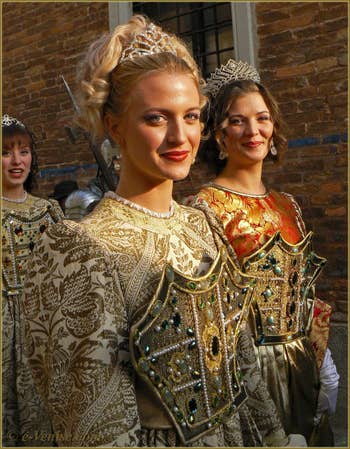
The Feast of the Maries From there, everyone gathered in a splendid procession to accompany the Maries, who were carried in triumph to San Marco, to attend holy mass.
Then they walked to the church of Santa Maria Formosa.
A variant was also introduced: they were also walked along the Grand Canal from San Marco to Rialto, and then on foot from Rialto to Santa Maria Formosa. Wherever the procession passed, musicians played all kinds of instruments to add pleasure and joy to the beauty of the spectacle.
The Feast of the Marys became increasingly important, and it was decided that the richest families would take it in turns to receive the Marys in their palaces and offer them a banquet.
The banquets were followed by concerts, shows and games.
They were called "Ludi Mariani", which can be translated as "Marian Games".
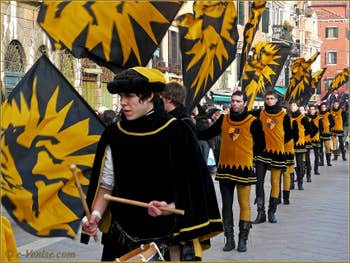
Marie de Tola Even back then, it seems, the Festa delle Marie attracted many foreign visitors to Venice.
The festivities became so important that the Festa delle Maries ended up lasting eight days.
The last seven days were a continuous festival: dances, fancy dress, comedy, regattas and a thousand other games during which the young girls could free themselves from the reserve imposed by the modest costumes of the time.
But they had to get serious again on the last day, when they went in procession to Santa Maria Formosa!
A Venetian painter, Gabriel Bella, painted a picture of this festival at the height of its splendour:
Unfortunately, all this ended up costing the city more and more, and the great families of Venice, who sometimes went so far as to go into debt, for the sake of prestige.
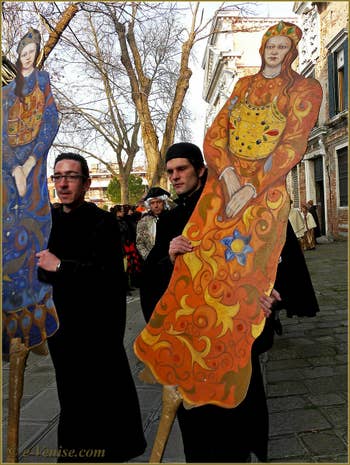
Marie de Tola To the economic disorder caused by all these petty rivalries between the "sponsors" was added the loosening of morals during these festivities, which only flattered the pride of the Maries.
So much so that in 1272 the Serenissima government reduced the number of Maries to four, then to three!
And as if that wasn't enough, in 1349, they finally replaced the young girls with wooden dolls made at the Arsenal.
The Venetians nicknamed them "Marione" or "Marie de Tola" (terms that still refer to cold, proud women today) and showed their displeasure by greeting them with shouts and whistles... or by bombarding them with raves or turnips! It was then forbidden to throw turnips, on pain of a fine.
The beauty and joy associated with the Feast of the Maries had disappeared.
In 1380, the Feast of the Maries disappeared... only to reappear in 1999!

The Feast of the Maries In 1380, after the disastrous War of Chioggia, all festivities linked to the Festa delle Marie and the "Ludi Mariani" were definitively abolished by the Serenissima, which preferred to make better use of its finances.
All that remained of this four-century-old festival was the Doge's annual visit to the church of Santa Maria Formosa on the second of February.
Thankfully, in 1999, and as in the past, the Venetians chose the most beautiful Maries from among the candidates who had sent their photos to the Gazzettino, the Venetian daily newspaper.
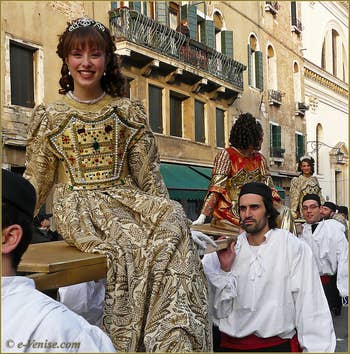
The 2008 Maria Giulia Stefinlongo And, in 2008, to celebrate the tenth anniversary of this superb festival, Venetians were also asked to choose "the Maria of the Venetians", from among the twelve Maries, by writing her name on a Gazzettino ballot paper entitled: Vota "La Maria dei Veneziani" La mia preferita è ..... (here they write the first name and surname of the one they prefer).
And the Venetians' and Il Gazzettino readers' Mary of Hearts for 2008 was Giulia Stefinlongo, from Murano (pictured opposite).
And as you can see from the photographs of the Feast of the Brides, this ancient festival has remained very Venetian but also very natural, with the girls and young men playing their roles without ostentation, simply happy to be able to take part in this magnificent procession.
So, if you're in Venice at the time of the Festival of the Brides, we really recommend you attend, as it really is a very, very beautiful festival.
Celebrations Historical Regatta | Redentore | Salute | Vogalonga | Marathon | Marys | St Martin
What's On Celebrations | Exhibitions | Biennale | Mostra Cinema
Back to Top of Page

